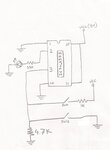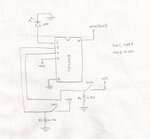sharikbaig
Member level 1

 Hi All,
Hi All,I have attached an image of the circuit diagram. The led in the circuit is always Off. It just turns on when i press SW1, but it again turns Off as soon as i release SW1. It doesnt latch in HIGH state. Can anyone please help me sort out the problem ?.:sad:
Datasheet of 74LS373 is also attached.View attachment sn74ls373rev5.pdf
Thanks in Advance !
Last edited:




